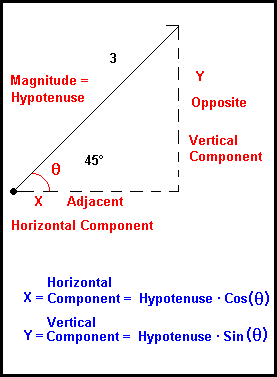It seems that vectors is just one of those words that strikes fear in many students old and young alike. However, with the right fundamentals and techniques, the subject of vectors can be conquered without either extraordinary mathematics skills nor knowledge of physics. Before one can begin learning about vectors, he/she must first learn what a vector is. According to the Merriam Webster Dictionary, a vector is
a variable quantity that can be resolved into component. To simplify this, here is an actual vector:
A vector has three types of information: 1. the length
2. the angle
3. the direction
Now that we know what a vector is and what it signifies, we can start to conduct simple addition question for vectors.
If the vectors that we are adding have a distinct direction (North, South, East or West), then we just connect them.
As you can see from this picture, the addition of vectors usually results in an imaginary triangle. After adding the horizontal component and the vertical component, you connect the origin to the ending point using a straight line. The first thing that you will need to calculate is the length of the hypotenuse. Due to the fact that you will know the lengths of the horizontal and vertical vectors, you can apply the Pythagorean Theorem:

Once you finish that, you will have the length of the vector. However, as I stated earlier, a vector has three components. Length is only one of the components. We also have to find the direction and the angle. To find the angle, we must measure angles with respect to North and South. If you are confused, simply draw a cross at the origin to display to you North, South, East and West. Now, you must apply simple trigonometry. Once you find out the right angle to measure, you can use tan, which is the length of the opposite side divided by the length of the adjacent side. Finally, you will have the angle. The last step is to simply state what direction the vector is going. To do this, you just need to look at the angle that you previously discovered. Since the angles are measured with respect to North and South, simply write East/West of North/South (whichever ones apply to your question)
Your end result should look somewhat like this: x=__m (N__ E)
And that's all you need to know about vectors for now!



No comments:
Post a Comment